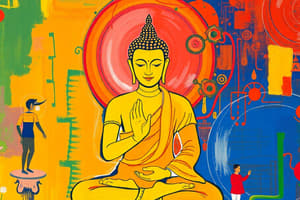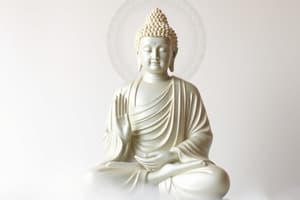Podcast
Questions and Answers
What is the ultimate goal of Buddhist practice?
What is the ultimate goal of Buddhist practice?
- Material success
- Enlightenment
- Happiness
- Nirvana (correct)
What are the three poisons that Nirvana is said to extinguish?
What are the three poisons that Nirvana is said to extinguish?
- Pride, envy, and laziness
- Love, fear, and ignorance
- Joy, sadness, and anger
- Greed, hatred, and delusion (correct)
What is sopadhishesa-nirvana?
What is sopadhishesa-nirvana?
- A state of mind that is not related to Nirvana
- Nirvana without a remainder, achieved on death
- Nirvana with a remainder, achieved on death
- Nirvana with a remainder, attained and maintained during life (correct)
What is the difference between the two types of Nirvana identified by the Theravada tradition?
What is the difference between the two types of Nirvana identified by the Theravada tradition?
What is the Mahayana tradition's highest goal?
What is the Mahayana tradition's highest goal?
What is the classic Mahayana Yogacara view on Nirvana?
What is the classic Mahayana Yogacara view on Nirvana?
What is the difference between the two models on the bodhisattva's attitude to Nirvana?
What is the difference between the two models on the bodhisattva's attitude to Nirvana?
What is the Dhammakaya Movement's interpretation of Nirvana?
What is the Dhammakaya Movement's interpretation of Nirvana?
What is the Mahayana tradition's view on the bodhisattva path?
What is the Mahayana tradition's view on the bodhisattva path?
Flashcards
Nirvana
Nirvana
The ultimate goal of the Buddhist path, marking the complete liberation from suffering and rebirth in the cycle of samsara.
Three Fires
Three Fires
The three fires are greed, aversion, and ignorance, which are seen as the root causes of suffering.
Sopadhishesa-nirvana
Sopadhishesa-nirvana
The first stage of Nirvana, attained and maintained during life, where one has overcome the 'three fires' but still has a physical body and remains subject to some aspects of the cycle of rebirth.
Parinirvana
Parinirvana
Signup and view all the flashcards
Buddhahood
Buddhahood
Signup and view all the flashcards
Deathless
Deathless
Signup and view all the flashcards
Nirvana as a Transcendental Reality
Nirvana as a Transcendental Reality
Signup and view all the flashcards
Nirvana and Emptiness
Nirvana and Emptiness
Signup and view all the flashcards
Arahant and Nirvana
Arahant and Nirvana
Signup and view all the flashcards
Study Notes
Nirvana is the goal of the Buddhist path and marks the soteriological release from worldly suffering and rebirths in saṃsāra. It is commonly interpreted as the extinction of the "three fires", or "three poisons" of greed, aversion, and ignorance. Nirvana is part of the Third Truth on "cessation of dukkha" in the Four Noble Truths and the "summum bonum of Buddhism and goal of the Eightfold Path." Buddhist Theravada scholastic tradition identifies two types of nirvana: sopadhishesa-nirvana, literally "nirvana with a remainder," attained and maintained during life, and parinirvana or anupadhishesa-nirvana, meaning "nirvana without a remainder" or final nirvana, achieved on death, a death which is not followed by a rebirth or reincarnation in the usual way. The Mahayana tradition's highest goal is Buddhahood, where there is no abiding in nirvana. Nirvana is not necessarily related to ecstasy or bliss, although some commentators see such experiences as part of nirvana. Nirvana is used synonymously with moksha (Sanskrit), also vimoksha, or vimutti (Pali), "release, deliverance from suffering." Most modern scholars such as Rupert Gethin, Richard Gombrich, Donald Lopez, and Paul Williams hold that nirvāṇa (nibbana in Pali, also called nibbanadhatu, the property of nibbana), means the 'blowing out' or 'extinguishing' of greed, aversion, and delusion, and that this signifies the permanent cessation of samsara and rebirth. According to Collins, a synonym widely used for nirvana in early texts is "deathless" or "deathfree" and refers to a condition "where there is no death because there is also no birth, no coming into existence, nothing made by conditioning, and therefore no time." The cycle of rebirth and suffering continues until a being attains nirvana.Understanding Nirvana in Buddhism
-
Nirvana is a state of complete liberation from suffering and rebirth, and is the ultimate goal of Buddhist practice.
-
Nirvana is described as an objectless, infinite, unsupported, and non-manifestive state of consciousness beyond time and spatial location.
-
Scholars have debated whether early Buddhism shared similarities with Brahmanical beliefs, and whether the Mahayana tradition preserved a pre-canonical Buddhist tradition.
-
Nirvana can be seen as a transformed state of mind, and is described as a deathless sphere or transmundane reality.
-
Nirvana is also described as identical to anatta (non-self) and sunyata (emptiness or nothingness).
-
The Theravada tradition identifies two stages of Nirvana: one in life and one final Nirvana upon death.
-
The final Nirvana marks the complete cessation of everything, including consciousness and rebirth.
-
Nirvana is also described as the realization of an end state where many adverse aspects of experience have ceased.
-
In the Theravada tradition, Nirvana is regarded as an uncompounded or unconditioned dhamma (phenomenon, event) which is "transmundane" and beyond dualistic conceptions.
-
The mind of an arahant (fully awakened person) is believed to be Nirvana itself in modern Theravada practice tradition.
-
Nirvana is described as transcendent reality beyond existence and non-existence, and cannot be fully explained or grasped through language or logic.
-
Nirvana is commonly metaphorically described as a flame which goes out due to lack of fuel, and the Buddhist practitioner must "drop" the bundles of firewood that fuel the three fires to extinguish them.Interpretations of Nibbana in Theravada Buddhism
-
Nibbana is the ultimate goal of Theravada Buddhism and is described as the extinction of craving, aversion, and ignorance.
-
Nibbana is not a negative or annihilation, but rather a state of freedom and truth.
-
Traditional Theravada views see Nirvana as a reality transcendent to the entire world of mundane experience and all realms of phenomenal existence.
-
Sri Lankan philosopher David Kalupahana argues that dependent origination is operative in all spheres, including the highest state of spiritual development, Nirvana.
-
Mahasi Sayadaw, a 20th-century Theravada vipassana teacher, states that nibbana is the complete annihilation of the three cycles of defilement, action, and result of action, which all go to create mind and matter, volitional activities, etc.
-
Some Thai Theravada scholars see nibbana as equivalent to a special kind of mind or a special consciousness called anidassana viññāṇa, "non-manifest" consciousness which is said to be 'luminous'.
-
Ajahn Maha Bua taught the idea of "original mind" which when perfected is said to exist as a separate reality from the world and the aggregates.
-
The Dhammakaya Movement teaches that nibbana is not anatta but the "true self" or dhammakaya, which is a luminous, radiant, and clear Buddha figure free of all defilements and situated within the body of the meditator.
-
Ajahn Brahmāli concludes that the "most reasonable interpretation" of final nibbāna is "no more than the cessation of the five khandhas."
-
The Sarvastivada Abhidharma compendium, the Mahavibhasasastra, says of Nirvana that it is the cessation of all defilements and is equivalent to extinction through knowledge.
-
The Pudgalavada school interpreted Nirvana as the single Absolute truth which constitutes "the negation, absence, cessation of all that constitutes the world in which we live, act and suffer".
-
The Mahāsāṃghika school held that the Nirvana reached by arhats was fundamentally inferior to that of the Buddhas.Nirvana in Buddhism: Mahayana Perspective
-
Both samsara and nirvana were nominal designations devoid of any real substance according to Bareau.
-
The Mahayana tradition promotes the bodhisattva path as the highest spiritual ideal over the goal of arhatship.
-
Remaining in samsara to help other beings is a noble goal for a Mahayanist.
-
There are at least two conflicting models on the bodhisattva's attitude to nirvana.
-
The first model states that a bodhisattva postpones their nirvana until they have saved numerous sentient beings.
-
The second model doesn't teach that one must postpone nirvana and eventually developed a comprehensive theory of nirvana called apratiṣṭhita (non-abiding).
-
The classic Mahayana Yogacara view posits that there are at least two types of nirvana, holding that ''apratiṣṭhita-nirvana'' to be the highest nirvana, and more profound than ''pratiṣṭhita-nirvāṇa''.
-
According to Robert Buswell and Donald Lopez, ''apratiṣṭhita-nirvana'' is the standard Mahayana view of the attainment of a Buddha.
-
Most sutras of the Mahāyāna tradition present three alternate goals of the path: Arhatship, Pratyekabuddhahood, and Buddhahood.
-
The Mahāyāna commentary the Abhisamayalamkara presents the path of the bodhisattva as a progressive formula of Five Paths (pañcamārga).
-
According to the Mahayana tradition, only Buddhas have omniscience knowledge.
-
The Mahayana tradition discusses nirvana with its concept of the tathāgatagarbha, the innate presence of Buddhahood.
Studying That Suits You
Use AI to generate personalized quizzes and flashcards to suit your learning preferences.




